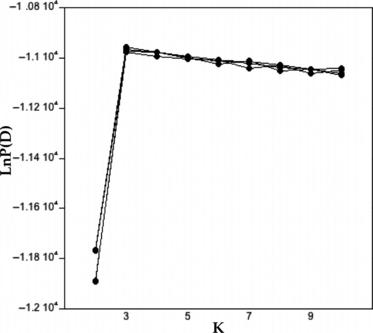Hybridization and invasion: one of North America's most devastating invasive plants shows evidence for a history of interspecific hybridization
- PMID: 25567902
- PMCID: PMC3352454
- DOI: 10.1111/j.1752-4571.2009.00097.x
Hybridization and invasion: one of North America's most devastating invasive plants shows evidence for a history of interspecific hybridization
Abstract
Hybridization has been hypothesized to influence invasion through the generation of novel phenotypes and/or increased levels of genetic variance. Based on morphology, hybrids between diffuse knapweed and spotted knapweed, two invasive plants in North America, are present in the invaded range. Some individuals within most diffuse knapweed sites in North America exhibit intermediate diffuse × spotted floral morphology. We examined hybridization at the molecular level, using amplified fragment length polymorphisms. Approximately a quarter of the assayed North American diffuse knapweed individuals exhibited evidence of introgression from spotted knapweed. However, plants with intermediate morphology did not show evidence of mixed ancestry more often than the plants with typical diffuse knapweed morphology. The high proportion of hybrid individuals in North American diffuse knapweed sites found here, combined with evidence from recent studies, suggests that diffuse knapweed was likely introduced with admixed individuals, and the hybrids are not newly created postintroduction. A century of backcrossing with diffuse knapweed has likely decoupled the relationship between morphology and admixture at the molecular level. In contrast to the scenario encountered in North America, in the native range where diploid diffuse and spotted knapweed overlap, hybrid swarms are common. In such sites, the floral phenotype aligns more closely with the genotype.
Keywords: STRUCTURE; amplified fragment length polymorphism; biological invasion; diffuse knapweed; hybridization; spotted knapweed.
Figures






References
-
- Arnold ML. Natural hybridization as an evolutionary process. Annual Review in Ecology and Systematics. 1992;23:237–261.
-
- Arnold ML, Bulger MR, Burke JM, Hempel AL, Williams JH. Natural hybridization: how low can you go and still be important? Ecology. 1999;80:371–381.
-
- Blair AC, Hufbauer RA. Geographic patterns of interspecific hybridization between spotted knapweed (Centaurea stoebe) and diffuse knapweed (C. diffusa. Invasive Plant Science and Management. 2009;2:55–69.
-
- Blair AC, Hanson BD, Brunk GR, Marrs RA, Westra P, Nissen SJ, Hufbauer RA. New techniques and findings in the study of a candidate allelochemical implicated in invasion success. Ecology Letters. 2005;8:1039–1047.
-
- Blair AC, Nissen SJ, Brunk GR, Hufbauer RA. A lack of evidence for a role of the putative allelochemical (±)-catechin in spotted knapweed invasion success. Journal of Chemical Ecology. 2006;32:2327–2331. - PubMed
LinkOut - more resources
Full Text Sources

